Many
researchers were responsable for the development of the
cathode ray tube. In this way, the first application of
cathode rays to engineering measurements was made by Karl
Ferdinand Braun in 1897 by mean of his experimental device
as known as the Braun tube. (a)
It consisted of a glass tube comprising in one of its
end the cathode. The anode is inserted in the side of
the tube so as not to be in the path of the ray beam,
whose cylindrical shape is controlled by the diaphragm,
a plate with a circular central hole. In the other end
of the Braun tube there is a mica plate or the screen.
Its side facing to the ray beam is coated with a fluorescent
mineral substance. When the tube is excited the screen
shows a bright luminescent spot upon its bombardment by
the cathode rays. This spot may be deflected in any direction,
vertical or horizontal, by means of an electrostatic or
magnetic field in such away two electrical phenomena in
their mutual relatioship can be displayed on the fluorescent
screen, for instance, the linear increasement of a current
with the time, giving the birth of the cathode rays oscillograph.
(b)
In spite of such electrical measurements, the Braun tube
could be used also for others applications. In this way,
if the electron bean zigzag or electrical scanning on
the screen is made to vary in accordance with the brightness
of each point of a picture, the same could be used for
reproducing black and white images in the form of a line
pattern. Over the years, since its invention in 1894,
the Braun tube was upgraded by constantly technological
improvement up to the modern cathode rays tube as kown
as kinescopes. (c)
At the beginning of 1950, the kinescopes were still manufactured
in a round shape with 23 cm in size and thus producing
small image area. In order to compensate such technical
handicap, the first television receivers were built using
a kind of optical system in such away the kinescope image
was projected on a translucent screen. (d)
Nowadays, the kinescope screen is manufactured by using
complex mixtures of fine powders called as phosphors.
In order to improve light efficiency of the screen a thin
layer of Aluminium is applied across the inside of the
powder substrate. In this way, this kind of surface finishing
as known as, metal backing works as a reflector and returns
all ligh bean directed inward. (e)
Due to the continuous technological development, new types
of screen concepts, such as the ones using the Plasma
and the LCD tehcnology, soon will replace the traditional
kinescope. The LCD screen consits of thousands of liquid
crystal sensors, whose ultra-fast luminous response will
be controlled by light filters. A very thin solid-state
device, in a transparent film shape with 0,3 micron in
thickness, similar to a transitor, will supply the proper
voltages in time intervals of thounsands of seconds, producing
high definition colored images. (f) |
 |
(a) Esquemático do tubo de Braun, projetado
em 1897.
The Saga of Vacuum Tube |
(b) The discovery of the cathode
rays. It was a consequence of the studies for the development
of the atomic theory. Around 1830, during his electrochemical
experiments, Faradys observed the effect of application
of high potential between two electrodes within crudely
evacuated glass envelope.
Later Faraday's observation was confirmed by Crook's experiment.
Basically, it consisted to connect the poles of high potential
source to two metals plates inside an air evacuated glass
tube.
During the experiments Crooks noted that the glass tube
walls emitted a faint greenish light. The Crookes's tube
showed that the fluorescence or rays were more properly
discrete particles leaving the cathode at righ angles
to its surface. Such phenonomen was named as cathode rays. |
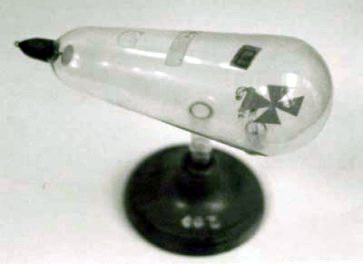 |
|
(b2) the Crooks'
tube
|
|
|
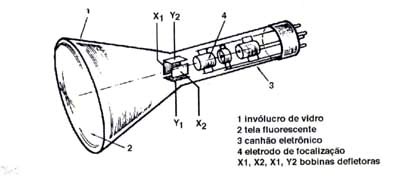 |
| (c) A modern cathode rays tube. |
|
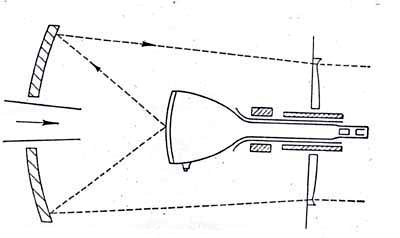 |
| (d) Diagram
of a projection television system. |
 |
| e) The cathode rays tube type
MW6-2 made by Philips for the first televison receivers
using a projection optical system. |
|
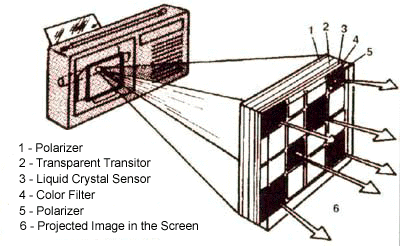 |
| (f) The micro-screen operation principle
provided with LCD sensors. |
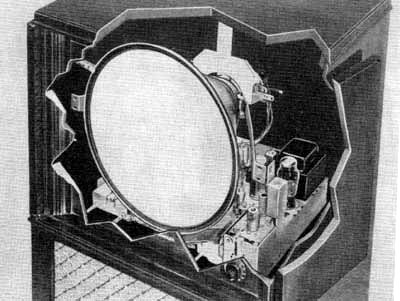 |
| (g) Magazine
Communication, Feb. 1939.. |
|
|
|